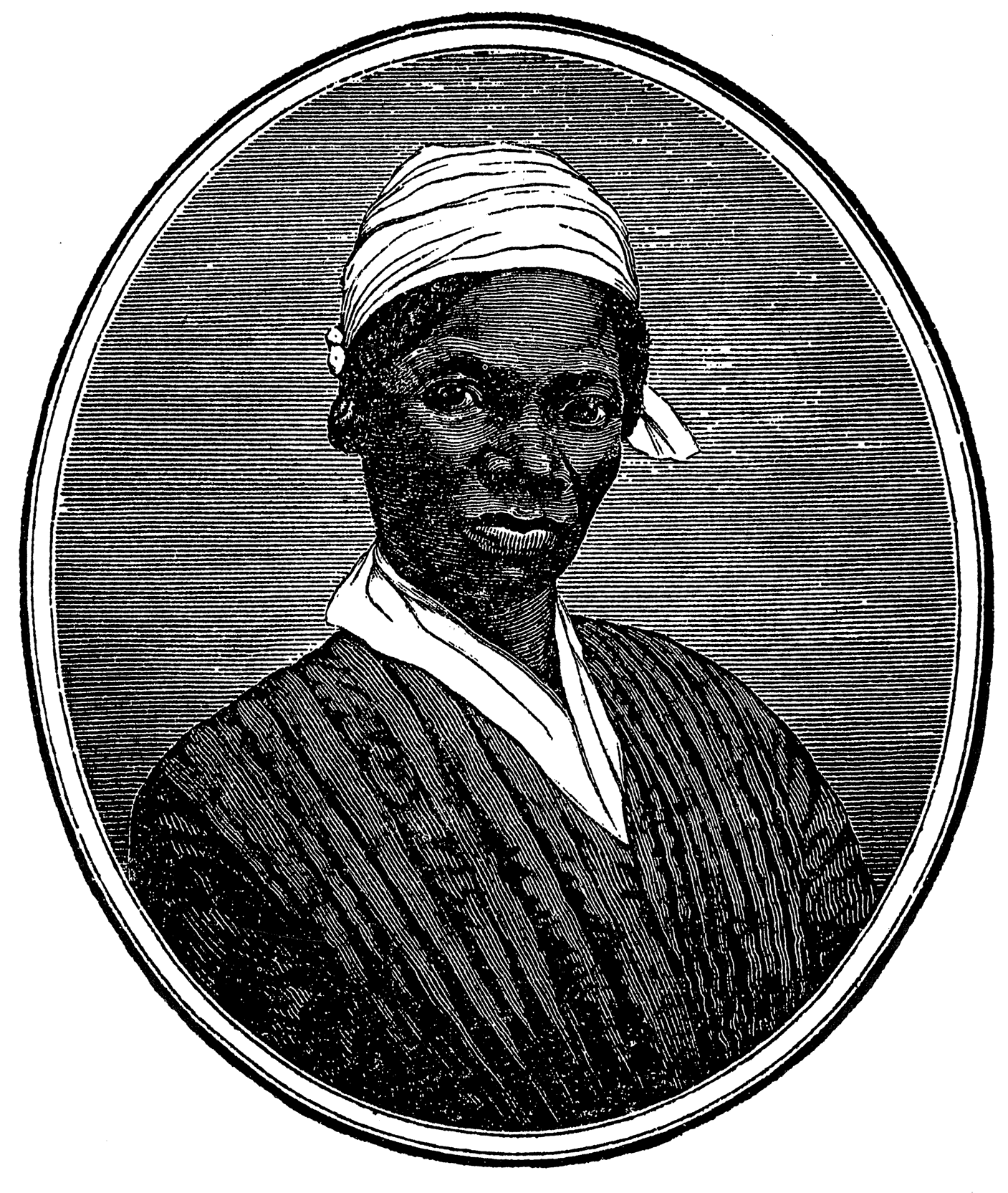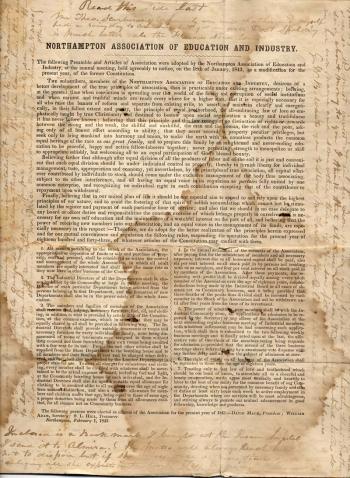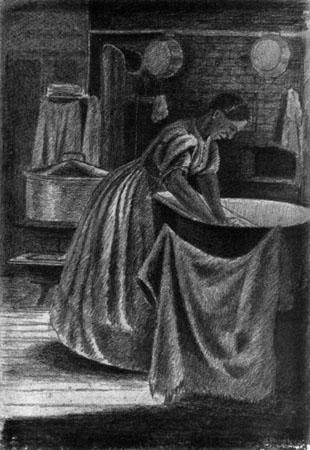Experiment in Politics
In 1842, seven men formed a community in western Massachusetts, called the Northampton Association of Education and Industry. Their utopian community would come to be one of many democratic experiments of the early 19th century. Throughout its short existence the members of the Northampton Association for Education and Industry attempted to create a new egalitarian model for an existing society, which they viewed as corrupt and immoral. (View the NAEI constitution)
Democracy in the Mid-Nineteenth Century
in the margins of the Northampton Association
Constitution, combining his words and their
beliefs to convince his wife and family to
move to Northampton.
Letter courtesy of Historic Northampton.
The 1830s and 1840s is deemed the Era of the Common Man it marked expanded democracy in America. The revoking of property requirements led to suffrage for all white males across the United States. Expanded political participation also took form in party nominating conventions, popular election of electors, the rise of third parties, more elected offices, and popular campaigning (link to parade letter). The expansion of democratic practice not only encouraged more participation but also sparked new debate over expanded rights for women and African Americans.
Combined with the religious revivals of the 1830s, this expansion in democracy helped to create the many reforms of the 1840s. Utopianismwas one strategy that some reformers used to explore ideas of expanded democracy and moral reform. In these intentional communities, members would attempt to create a democratic, moral, and/or economic model for the larger society, which they viewed as corrupted by social, political and economic problems. Massachusetts had several utopian communities, including Fruitlands, near Boston; Brook Farm, in West Roxbury; Hancock Shaker Village, in the Berkshires; and the Northampton Association of Education and Industry, in Northampton. Each utopian society had its own goals. Because of the rapid change in society, these communities could reasonably believe they would have an influence on society.
The communitarian moment of the 1840s was short lived and resulted from many changing aspects of society. Many of the reformers involved took part in these communities as one part of a lifetime of activism.
Democracy at the Association
The Northampton Association established an egalitarian community, which would inspire action for a better way of life. From the beginning, the Association did not have one leader and had rules and regulations which were set only to establish frameworks and a process for decision-making. The Northampton Association was similar to other communitarian groups in establishing a principle of brotherhood that was linked to “true” Christianity.
The founders and members of the Association believed that humans could live together harmoniously without the divisions of gender, race, and class. When they arrived in Northampton they received little welcome from the local people as their ideas were viewed as radical and even harmful. This reception only fueled the reformers higher purpose of revolutionizing the old system.
In February of 1843, Connecticut artisan James Stetson wrote to his wife, Dolly, to discuss the idea of moving their family to Northampton, MA to join the Northampton Association. Stetson penned his letter in the margins of the Northampton Association’s constitution. The constitution detailed a framework for their community expressing views about leadership, work and equality. (Constitution and By-laws, 1843) The Association’s interest in democratic process and in equality for all its members partly stemmed from religious principles. The members of the Association believed in non-resistance, a theory which extended anti-slavery reform into a full critique of existing society, government and institutions, including the church.
Their democratic principles extended to religion as the Association recognized no specific sect of Christianity and practiced religious tolerance. While acceptance and tolerance were essential, the Association regulated its membership making sure to accept only people who would uphold their moral standards. (22, 24)
In reading the Stetson letters, it becomes evident that groups, which were traditionally excluded from political and economic decisions, took a prominent role in the Association’s operations. Sojourner Truth held an esteemed position at the Association as head of the laundry. (image and letters 43) Dolly Stetson and other women consistently participated in the community meetings, voting, and debates. (Example) Evident from the first letter that James wrote to his wife about the Association, Dolly clearly participated in the decision-making in her family. (letter) Almira Stetson’s aspirations show support for women’s rights in politics, reform and education. Her desire to emulate self-educated women like Margaret Fuller, show her own goals but also the role her parents were willing to accept for her.
(39, 42) The participation of women in the community mirrored their larger effort to support the Garrisonian Abolitionists. The debate over women had divided the abolitionist movement and also caused the Association to receive criticism. Although these practices at the community embodied the principle of women’s equality, there was clearly a gendered division of labor based on rural New England society and some women clearly voted only with their husbands. (examples) The equality for women was at times practiced and at times symbolic.
The goal of racial equality also held as much symbolic significance as actual. While four African Americans lived at the Northampton Association, most members were white families that had community or reform connections. While it is unclear how many fugitive slaves passed through the association, it is clear that not many blacks even applied to be members. There is evidence that the community would accept black members with less scrutiny, presumably to promote their principles of equality.
Sojourner Truth and David Ruggles were treated as equals and took prominent roles within the community. Overall, their goals of establishing a multi-racial community mostly remained just that – goals. The community received scathing criticism for its African American participation, although it was minimal. (example from Chris’s book) Despite their efforts, the community’s racial composition reflected the broader color line of American society.
with laundry pans, cloths etc. hanging from
the brick wall. A dim light comes in from
the upper right. A wood stove and a large pot
for heating water stand behind the figure of
Sojourner Truth, who wears an ankle length
dress with the sleeves rolled up and her hair
pinned back. Although her clothing is plain,
she wears an earring. She leans over a large
laundry tub and works on a washboard,
wearing an expression of effort and concentration.
This image of Sojourner Truth, drawn in 1867 by a former Northampton Association member, depicts her washing laundry at the Association, where she was the director of the laundry department. In the nineteenth century, it was extremely rare for an African-American woman to supervise white workers. Image courtesy of Historic Northampton. For the members of the Association, education played a major role in the expansion of democracy. All members, young and old, received education at the Association. (2, 3,13) Work and study occupied 6 days a week, Sunday afternoon set for free meetings of adults, youth, and visitors where religious and moral subjects were debated. (8) The “learn-by-doing” model encouraged active participation. The Stetsons were clearly attracted to the Association for the education they would be able to provide for their children. (2)
The Industrial model established by the community also encouraged democracy and social responsibility. All members worked and contributed to the Association’s business—studying and working 6 days a week. Silk was chosen for both practical and symbolic reasons.The silk worm was a symbol of democracy—equal and classless. From 1843, regular business meetings were held on Saturday evenings for the whole community. Wages, production, and restructuring of industrial production were all debated by the community. (examples) The overall goal was to bring workers into harmonious cooperation with employers. There were no strict rules, instead relying on the voluntary efforts of the community to do what needed to be done.
In the end, it was not the social structure but the economic pursuits that led to the failure of the community. Their ideas of freedom and equality for women and African Americans, which seemed so radical at the time, would later be adopted by mainstream Americans and become an essential part of American society. Their questioning of the conflict between labor and capital would be taken up for decades to come. Their noble efforts to create a more democratic society called into question the greater ideas that were set forth within the nation’s Constitution.





